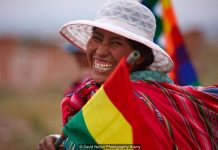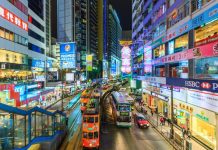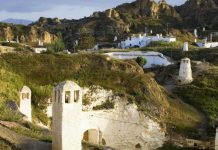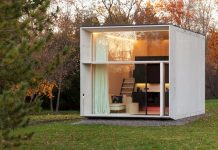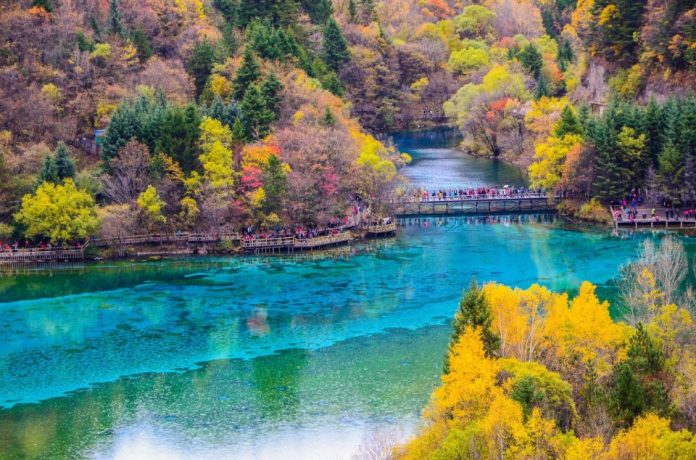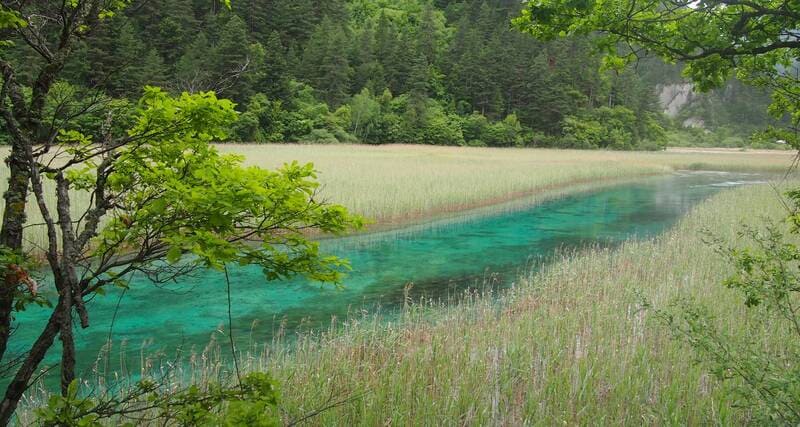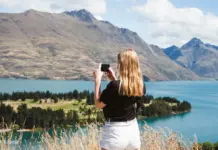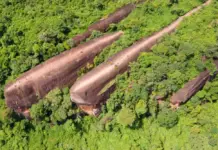Jiuzhaigou Valley Scenic Area is a famous scenic spot in China, located in the mountains of Sichuan Province. The name “Jiuzhaigou” comes from the presence of 9 Tibetan villages living around this area. “Jiu” means “nine”, “Zhai” means “village”, and “Gou” means “surrounding scenery”. This name represents the solidarity and unity between the 9 Tibetan villages in the Sichuan mountains. So, how to visit Jiuzhaigou, how to get to Jiuzhaigou? Let’s check out our Jiuzhaigou travel blog with the ultimate Jiuzhaigou travel blog to find out the answer!
- The ULTIMATE Lijiang travel guide: Top things to do, where to visit, stay, eat & MORE
- The FULLEST guide to Fenghuang Ancient Town: Top things to do, Eat, Tips & MORE
- Macau itinerary 2 days: How to spend 2 days in Macau perfectly from Hong Kong
- Must do in Macau: 11+ best things to do in Macau for First-Time Travelers
- Hangzhou itinerary 1 day: Slow Living in the Tech City with 1 day in Hangzhou
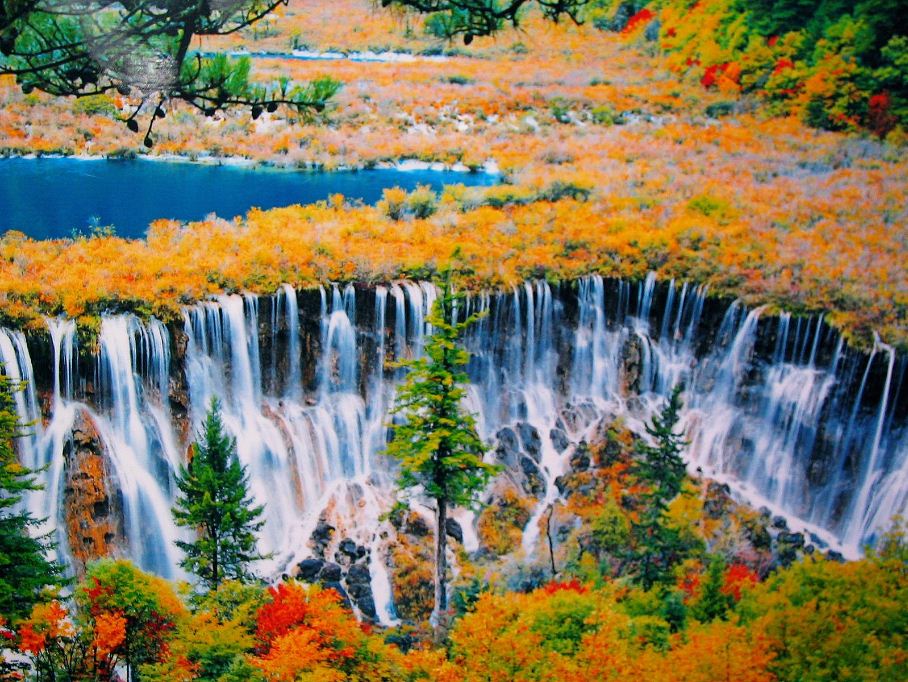
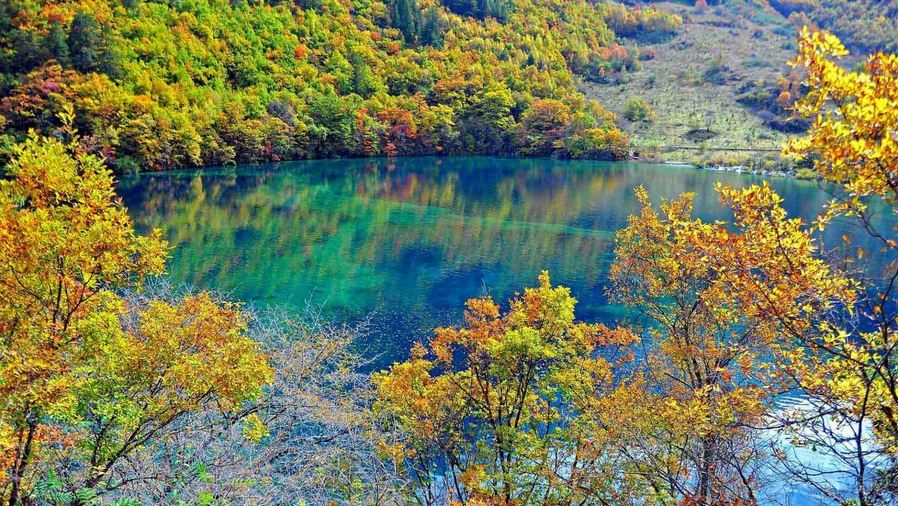
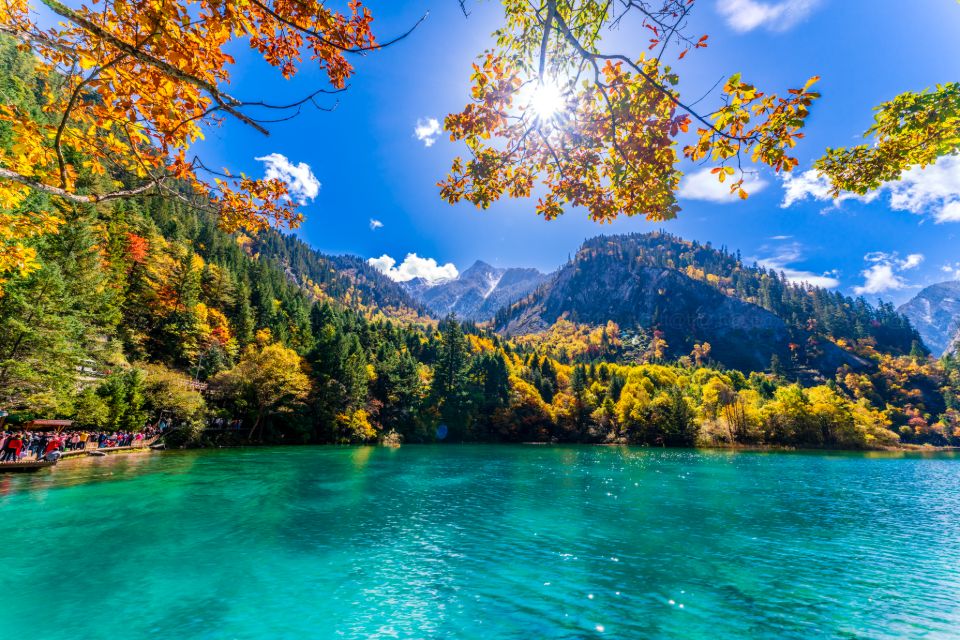
The most attractive thing here is the natural beauty of the mountains and forests. Especially in autumn, the leaves change color and the forest landscape becomes brilliant, creating a colorful natural picture. Jiuzhaigou is truly a wonderful destination for those who want to explore and experience nature. Especially for those who love mountains and forests and want to find peace and feel the breath of nature.
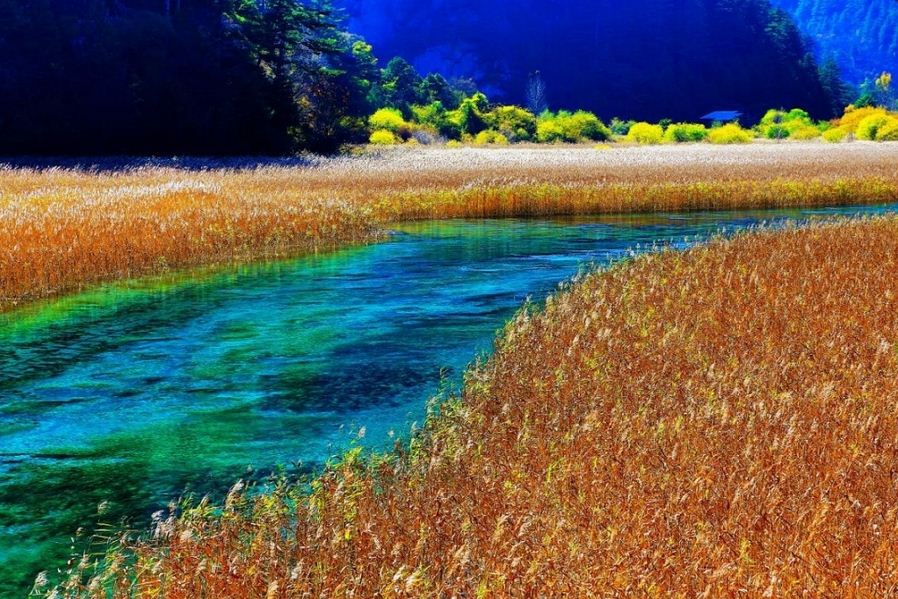
Jiuzhaigou has become a tourist attraction for domestic and foreign tourists with its majestic scenery and unique culture. So how can you save beautiful memories in Jiuzhaigou? This article will summarize all the experiences of traveling to Jiuzhaigou to prepare you for your upcoming trip.
Overview of Jiuzhaigou (#Jiuzhaigou travel blog)
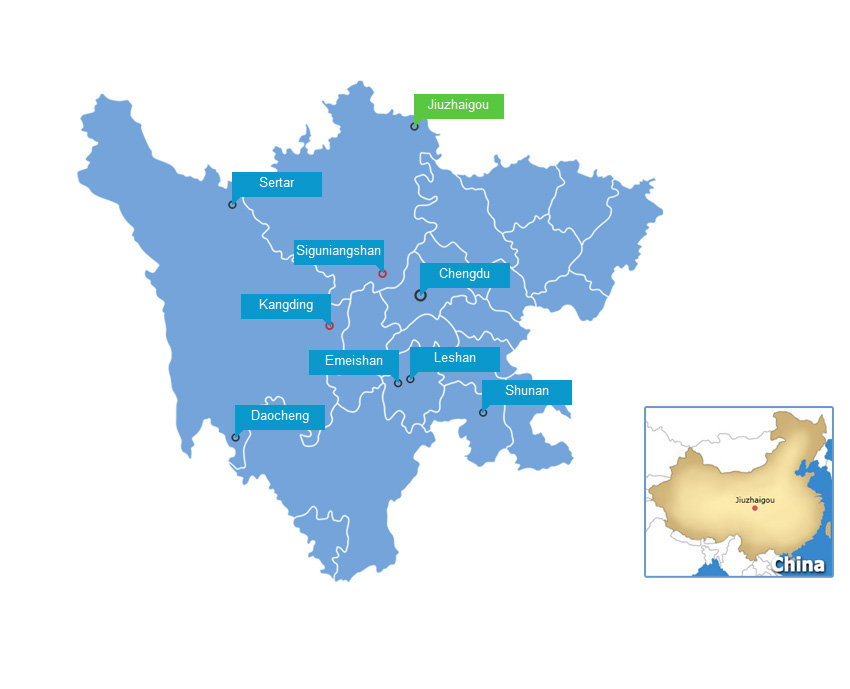
Jiuzhaigou Valley (also known as Nine Village Valley) is located in Zhangzha Town, Jiuzhaigou County, Aba Zang and Qiang Autonomous Prefecture, in the southern part of the Minshan Mountains in northwest Sichuan Province, and is located northeast of the Gonggan Ridge in the southern part of the Minshan Mountains.
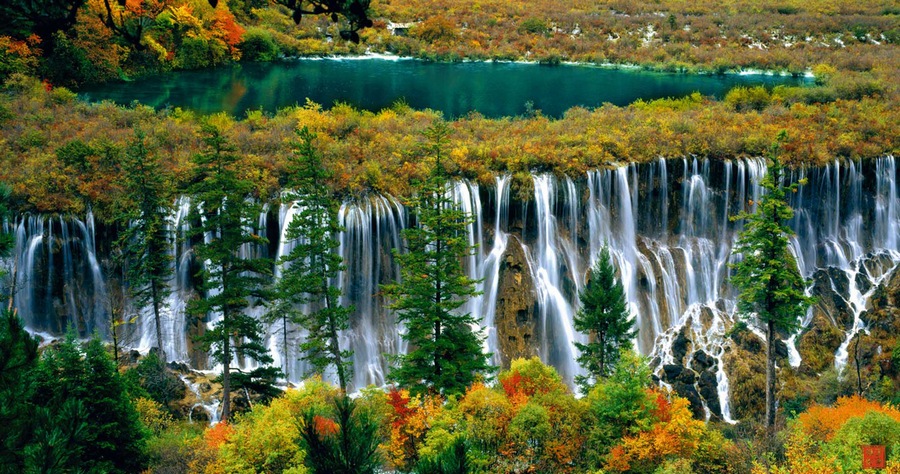
Jiuzhaigou is more than 400 kilometers away from Chengdu, and is a large branch ditch at the headwaters of the Baishui River in the upper reaches of the Jialing River of the Yangtze River system. The terrain of Jiuzhaigou Nature Reserve is high in the south and low in the north, with deep valleys and great elevation differences. The entrance to Jiuzhaigou on the northern edge is only 2,000 meters above sea level, the peaks and ridges in the central part are all above 4,000 meters, the southern edge is above 4,500 meters, the main ditch is more than 30 kilometers long, with a total area of 65,074.7 hectares.
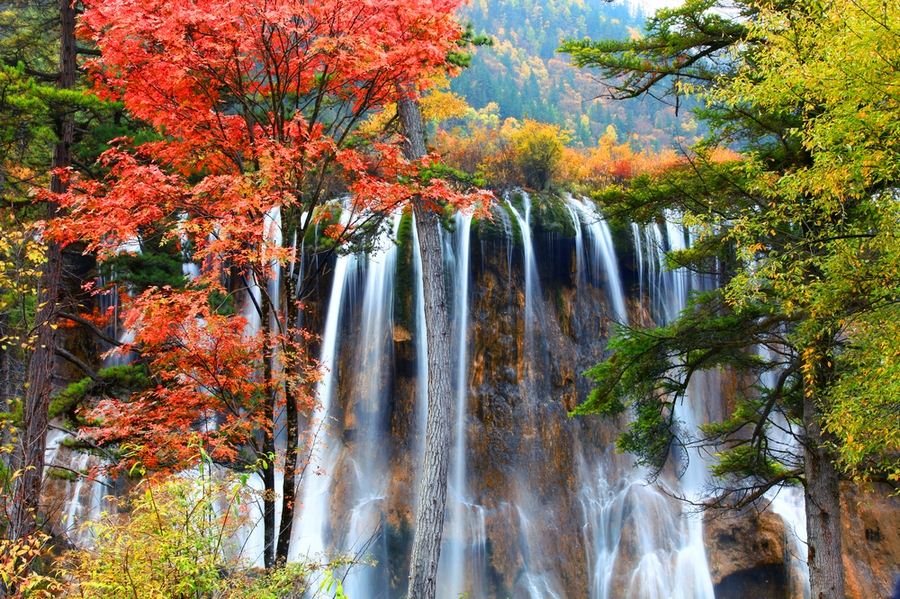
The entire Jiuzhaigou Valley scenic area is formed in the shape of the letter “Y”, the lower part of the letter “Y” is Shuzheng Valley, which is also the entrance to Jiuzhaigou Scenic Area. The left side of “Y” is Zechawa Valley, and the right side is Zechawa Valley, Rizegou. The main attractions of Jiuzhaigou are all located in these three valleys. According to Jiuzhaigou travel guide, the most beautiful scenery is the water scenery, with streams, waterfalls, rivers, and beaches connecting 108 clear, colorful lakes.
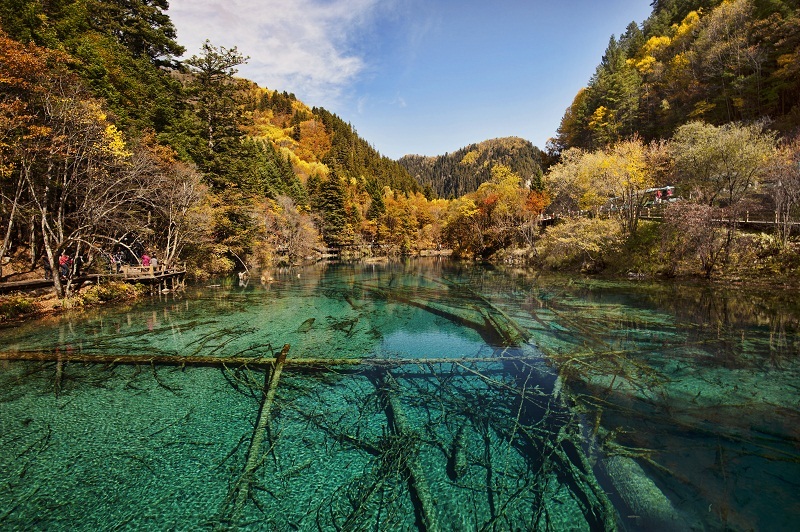
In addition to being a beautiful natural landscape, this place also has a perfect combination of pristine ecological environment, fresh air of mountains, forests and lakes. The streams in Jiuzhaigou are described as the soul of this land, because the transparency of the water is like crystal. In addition, Jiuzhaigou also has a rich diversity of flora and fauna resources with primeval forests covering the entire area. This place is also the habitat of many rare wild animals, especially giant pandas.
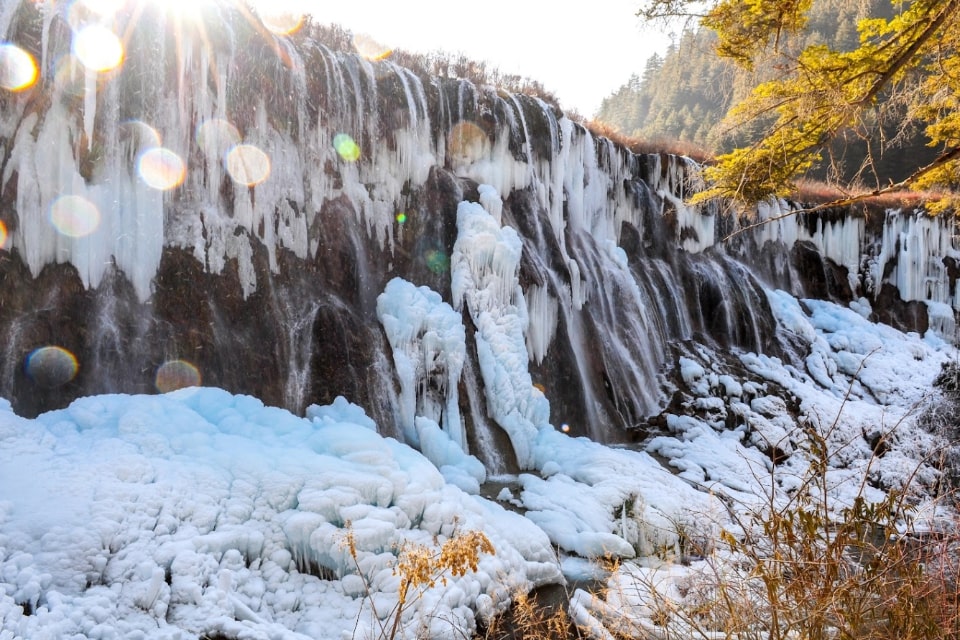
The landscape of Jiuzhaigou Scenic Area mainly consists of 3 main valleys: Shuzhenggou, Tazhagou and Rizhagou forming a Y shape. Among them, Shuzhenggou Scenic Area includes: bonsai garden, Reed Lake, Shuzheng Lake, Wolong Lake, Firelong Lake, Shuzheng Waterfall and other scenic spots. There are also large primeval forests covering the entire vast mountain, flowing through this primeval forest is a poetic stream named Love.
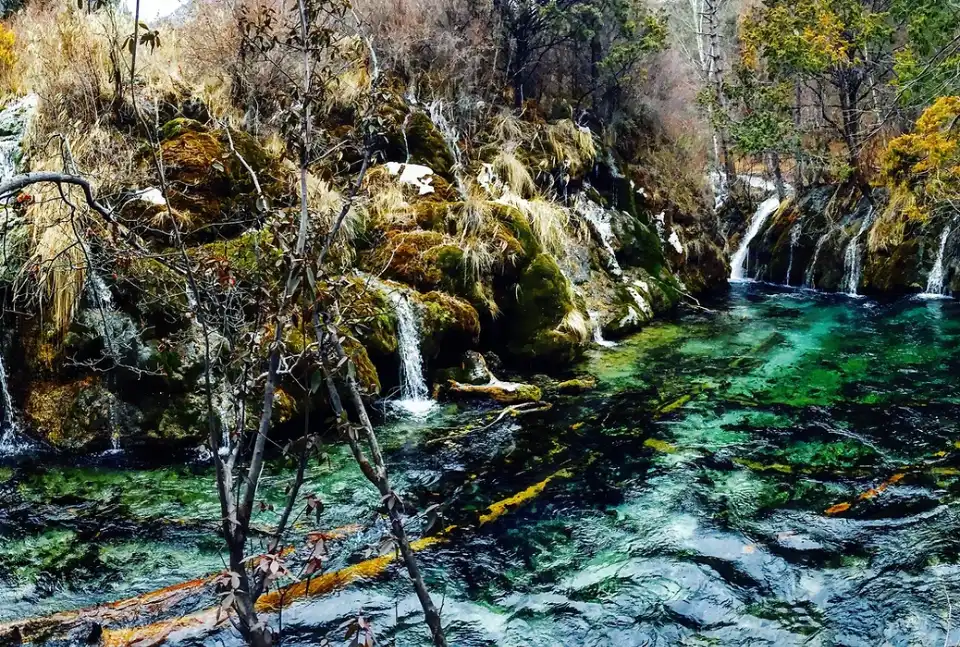
Jiuzhaigou is a majestic nature reserve with a variety of living species. This place is also known as a special national scenic spot. The highest point in Jiuzhaigou is 4800m. Inside this scenic spot, there are also lakes, waterfalls, snow-capped mountains and dense forests, creating an extremely beautiful and captivating landscape.
Jiuzhaigou was honored to be recognized by UNESCO as a world natural heritage in 1992. And once again recognized as a world biosphere reserve in 1997. In addition, Jiuzhaigou is also a protected landscape (category V) in the IUCN protected area classification system.
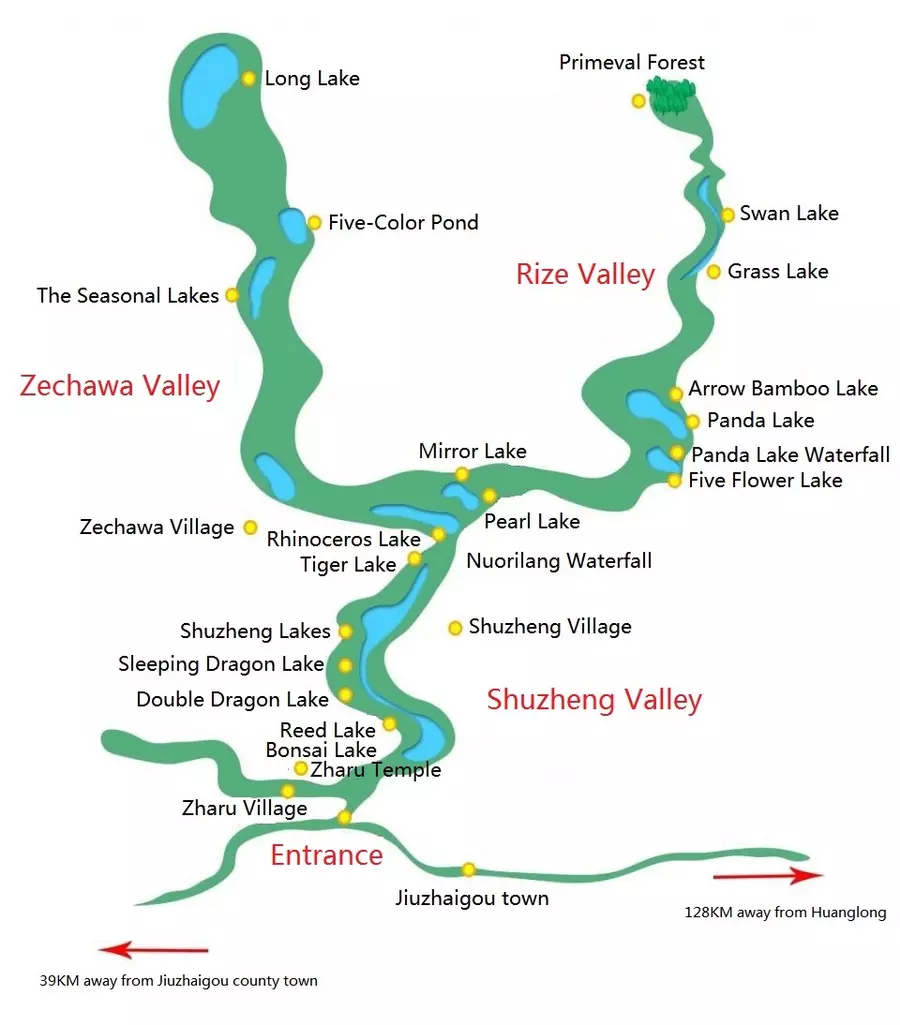
Experience Tibetan Culture
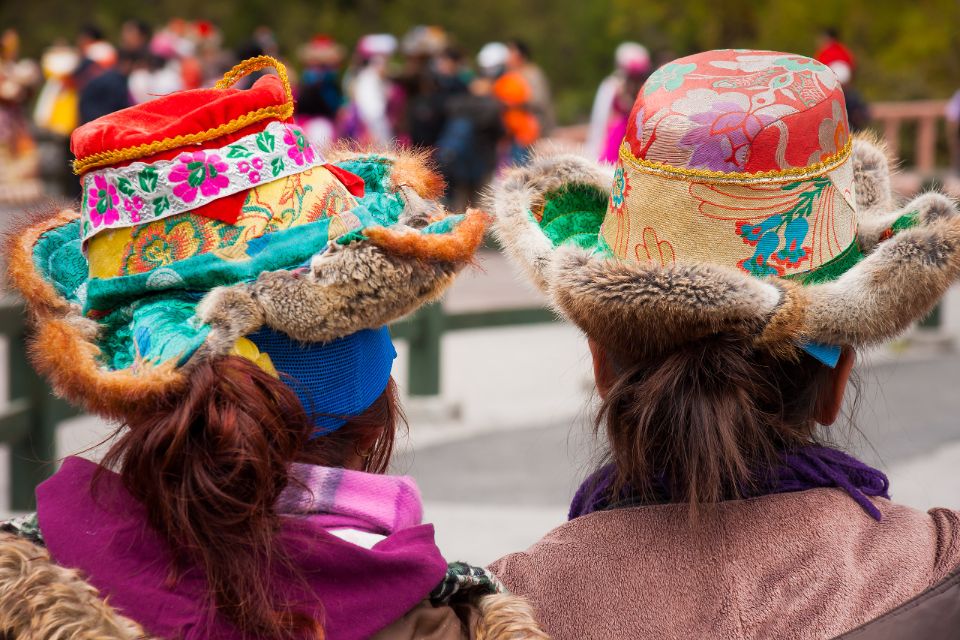
Jiuzhaigou is a settlement of Tibetans, its history and culture can be traced back to the Tang Dynasty. In the Jiuzhaigou scenic area, visitors can visit the architecture, temples and traditional handicraft production of Tibetans. In addition, Jiuzhaigou also preserves traditional Tibetan festivals and celebrations such as the Tibetan New Year and the Mountain Sacrifice Festival.
The typical customs of Jiuzhaigou are mainly reflected in the traditional lifestyle and customs of Tibetans. Here, visitors can enjoy traditional Tibetan dances, songs and handicraft making techniques. In addition, Tibetans in Jiuzhaigou also have some unique living habits such as playing waist drums, tug of war on the grasslands, etc.
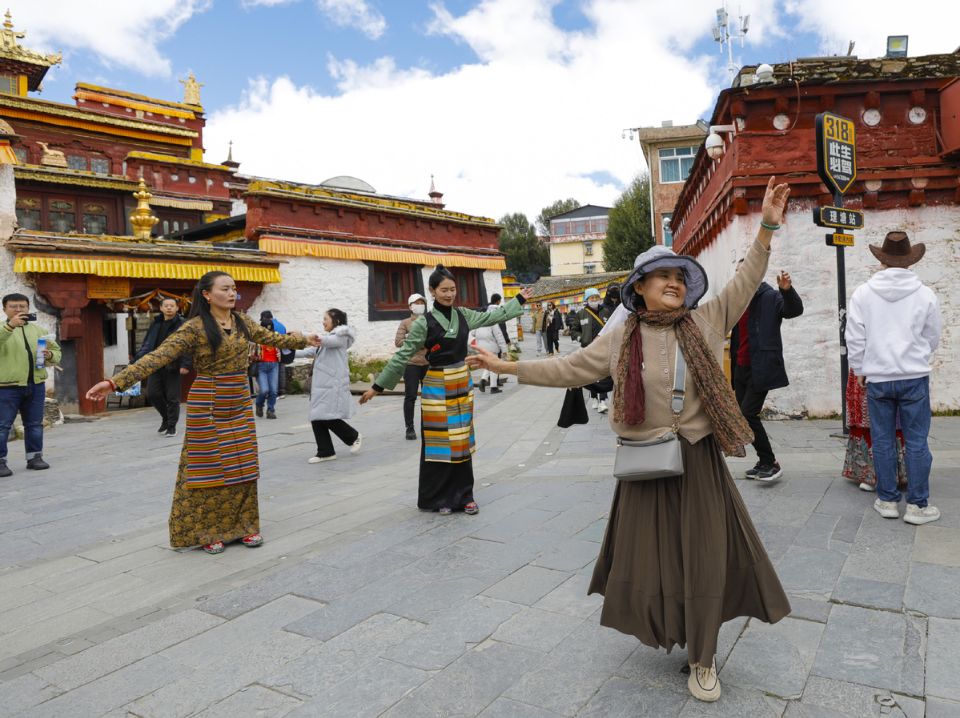
The clothing style in Jiuzhaigou is mainly Tibetan national costume, such as Tibetan robes, belts, socks, etc. These costumes have unique designs and patterns, reflecting the cultural characteristics and national spirit of the Tibetan people. When traveling to Jiuzhaigou, you can try on these traditional costumes to take souvenir photos.
Landscape Features of Jiuzhaigou Valley
Green Lake: Jiuzhaigou has many lakes, as blue as jade, with crystal clear water. Under the sunlight, the lake surface is like a giant mirror, reflecting the surrounding mountains and white clouds. Walking by the lake makes you feel like you are lost in a fairyland.
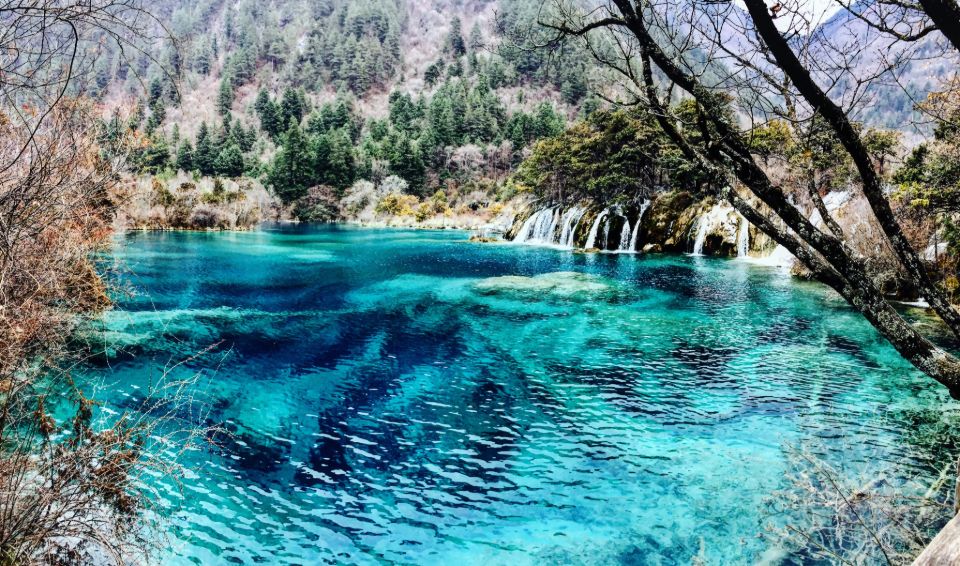
Spectacular Waterfalls: The waterfalls in Jiuzhaigou are also a beautiful sight. Nuorilang Waterfall is one of them, wide and spectacular, the water flows gracefully like a ribbon. When the water falls from above, the mist rises and the sound is like thunder, shaking people’s hearts.
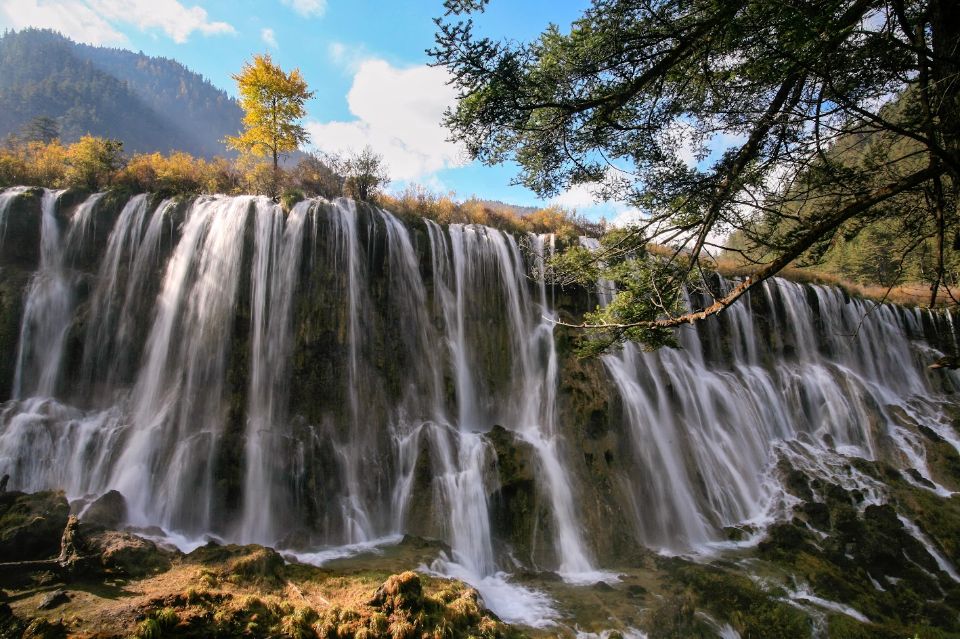
Majestic Mountains: The mountains in Jiuzhaigou Valley have many different shapes, some have steep cliffs, some have gentle peaks. These mountains show different colors and landscapes as the seasons change. Jiuzhaigou Valley is even more beautiful in autumn, the mountains and forests are all golden, like being in an oil painting.
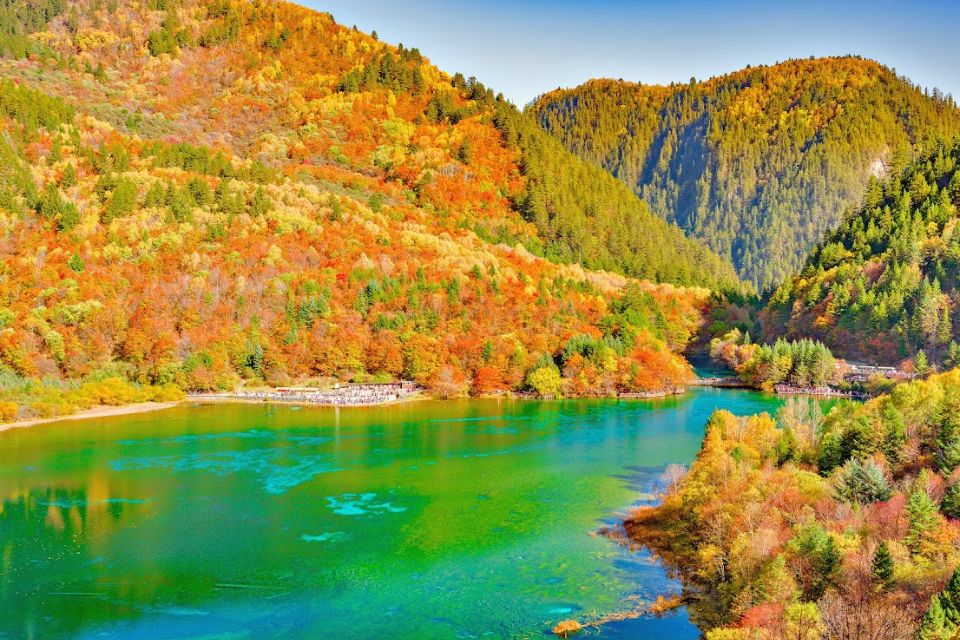
Rare Animals and Plants: Jiuzhaigou is rich in biodiversity, with rare animals such as white-lipped deer and golden monkeys, as well as many exotic plants. Walking in the forest, you can feel the magical charm of nature.
Opening Hours and Admission Fees
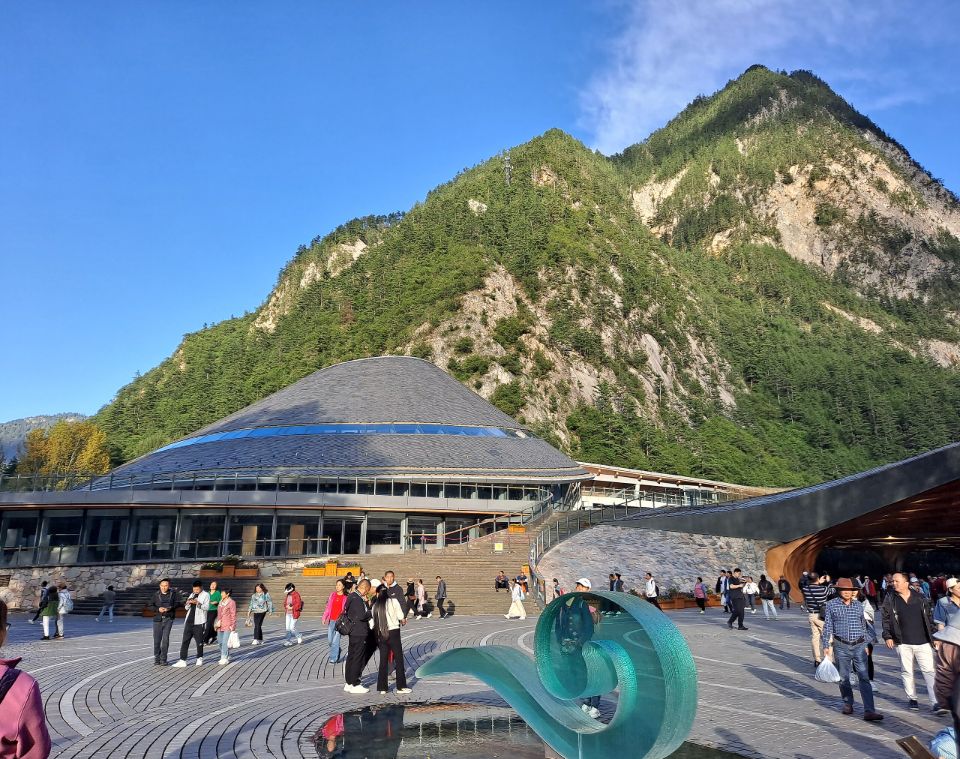
Jiuzhaigou is open all year round, but opening hours and admission fees vary by season:
- Peak season (April 1 – November 15): Admission fee 220 – 250 yuan/person (~750,000 – 850,000 VND), opens from 7:00 am.
- Low season (November 16 – March 31): Admission fee 80 – 100 yuan/person (~275,000 – 350,000 VND), opens from 8:30 am.
In addition, children under 6 years old or under 1.2m tall and people over 70 years old are exempt from admission fees. Bus fares range from 80 – 90 yuan (~275,000 – 310,000 VND), which is a necessary means of transportation to explore this vast area
When is the best time to visit Jiuzhaigou?
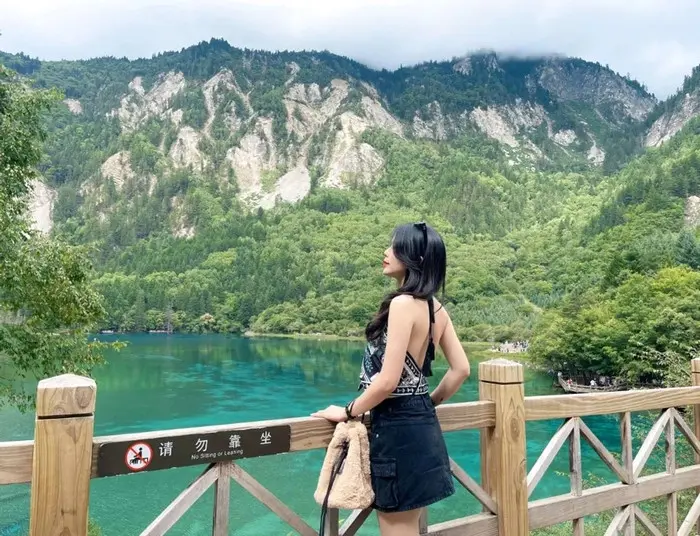
Jiuzhaigou Scenic Area is at an altitude of about 2,000 to 4,000 meters above sea level, with a humid plateau climate and snow-covered mountain peaks all year round.
- In spring, the temperature is low and varies widely, with an average temperature of mainly 9°C – 18°C. During this time, some areas often freeze and have snow.
- In summer, the temperature becomes warmer and more stable than in spring, with an average temperature of 19°C – 22°C. It will be a bit chilly at night, so you should prepare a thin sweater for your trip!
- In autumn, the sky is clear, the climate is more pleasant, the temperature is mainly from 7°C – 18°C, the temperature difference between day and night is large.
- From the end of October onwards, winter in Jiuzhaigou is relatively cold with temperatures mostly below 0°C. You should prepare a sweater or even wear many layers of clothes when coming here.

The weather here changes constantly, so the Jiuzhaigou management department has installed 4 large screens at the entrance to Jiuzhaigou. Thus, visitors can easily monitor the daily weather in the scenic area and arrange their visits appropriately. You should check the weather information a few days before the trip to prepare suitable clothes.
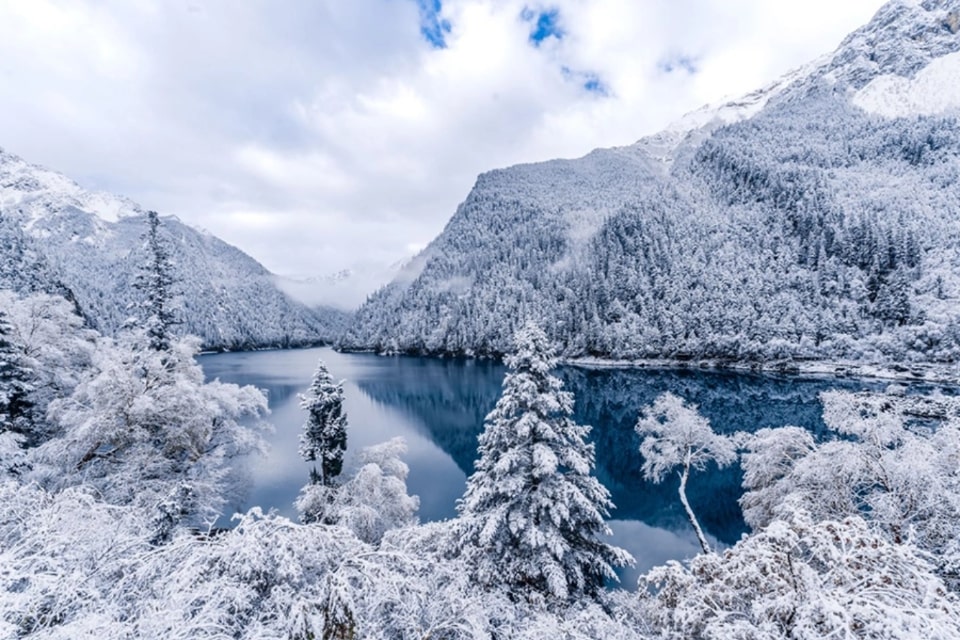
Jiuzhaigou has its own beautiful scenery all year round, it is only more beautiful but not the most beautiful, but if you ask when is the best time to go to Jiuzhaigou, the best tourist season in Jiuzhaigou is autumn (July – October) every year. At this time, the weather is cool, the temperature is suitable, and the fallen leaves on the ground create a beautiful and colorful landscape. At the same time, the water in Jiuzhaigou is relatively abundant, the water quality is clear and transparent, making the scenery of Jiuzhaigou even more majestic and charming.
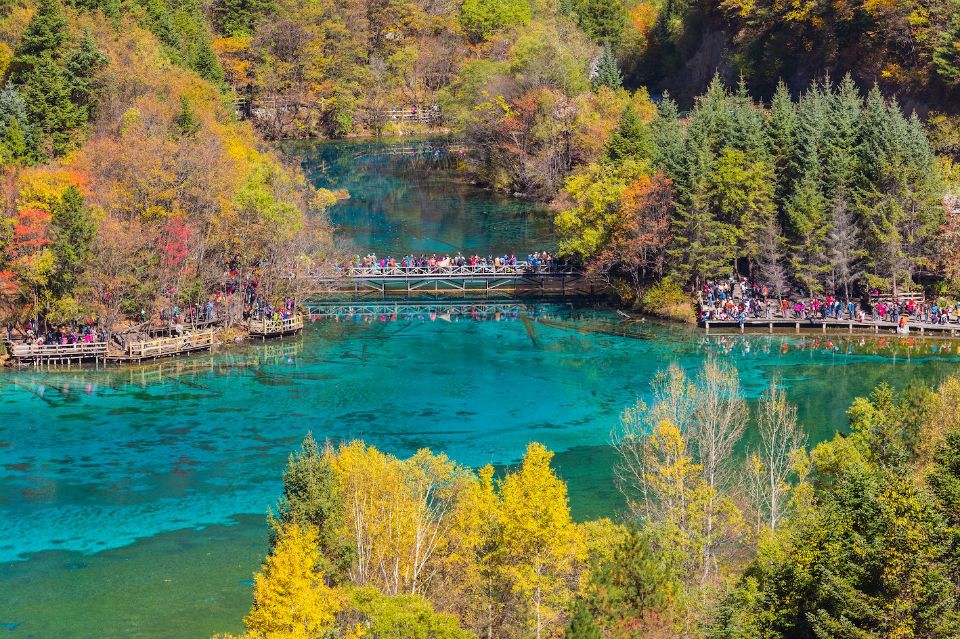
There are 2 reasons why autumn is the most suitable season to travel to Jiuzhaigou:
- The scenery is beautiful with fallen leaves and bright red reflections on the lake surface.
- The temperature is pleasant, ranging from 12°C – 16°C. During the day, the sunlight is gentle and not too cold, making it very convenient for traveling and moving comfortably.
Meanwhile, from May to June every year, Jiuzhaigou will also welcome a sea of blooming flowers, tourists who love the scenery of flowers and grass can also choose to visit Jiuzhaigou at this time.
How to get to Jiuzhaigou?
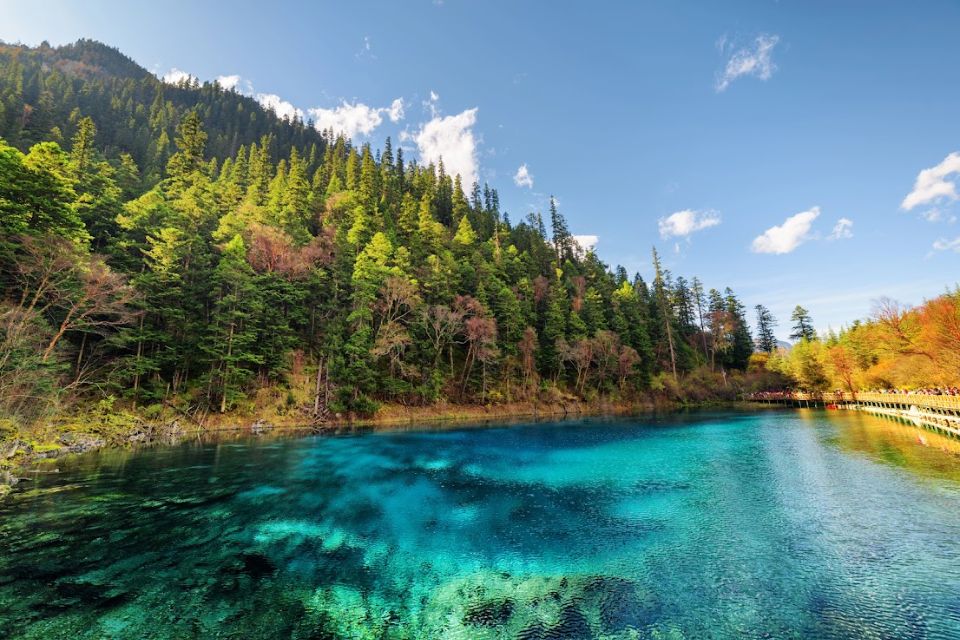
There are many means of transportation to get to Jiuzhaigou, you can choose the most suitable means for you.
By Road from Vietnam (#Jiuzhaigou travel blog)
If you want to see the beautiful scenery of China by road, you can start from Huu Nghi Border Gate (Lang Son Province, Vietnam). From there, drive to Nanning Airport and fly to Chengdu Airport. Then, continue by car for about 460km to Jiuzhaigou.
By Air
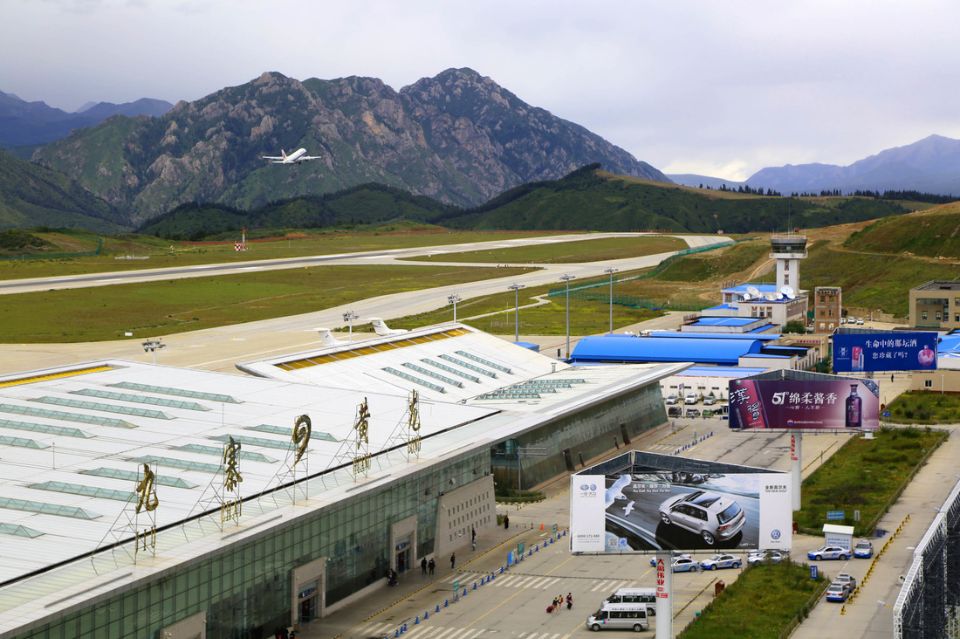
A more convenient way of traveling is by plane. Jiuzhaigou Airport located in Jiuzhaigou currently has direct flights to Chengdu, Chongqing, Beijing, Hangzhou, Shanghai and other cities. After arriving at Jiuzhaigou Airport, you can take a bus to Jiuzhaigou Scenic Area, which takes about an hour and a half.
Fly to Chongqing: You can fly to Chongqing Airport, then transfer to a high-speed train (1.5 – 2 hours) to Chengdu. From Chengdu, you continue by car for about 460km to Jiuzhaigou. Airlines operating this route include: China Eastern Airlines, Shenzhen Airlines, Sichuan Airlines, Air China, …
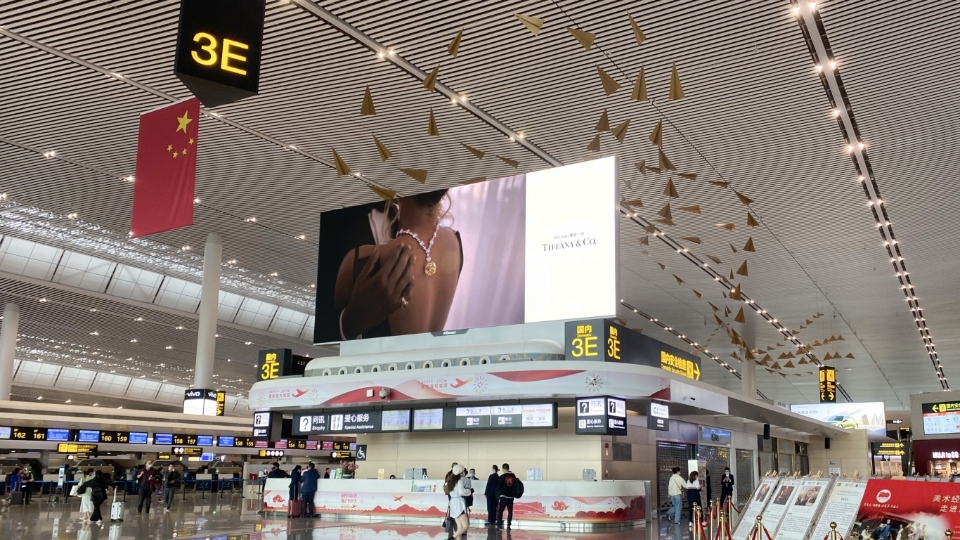
Fly to Chengdu: Traveling by bus will take quite a long time, from 7-8 hours with such a long distance, so traveling by air will save you more time. In one day, Chengdu will have about 20 flights to Jiuzhaigou and the flight time is about 1 hour. Reference ticket price: from 360 NDT/person for a one-way ticket.
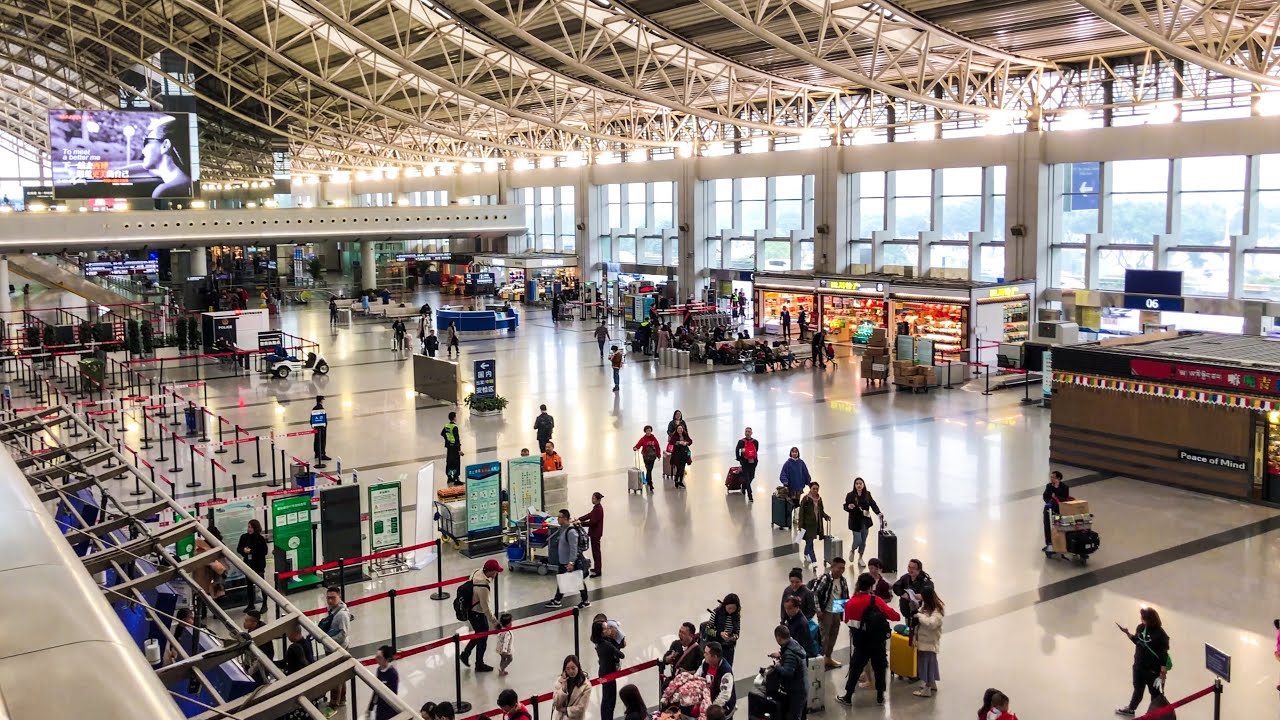
You can also fly directly to Chengdu airport and from there take a car to Jiuzhaigou. However, the number of flights to Chengdu airport is quite small, so the best way to travel is still to fly to Chongqing airport.
Train and road
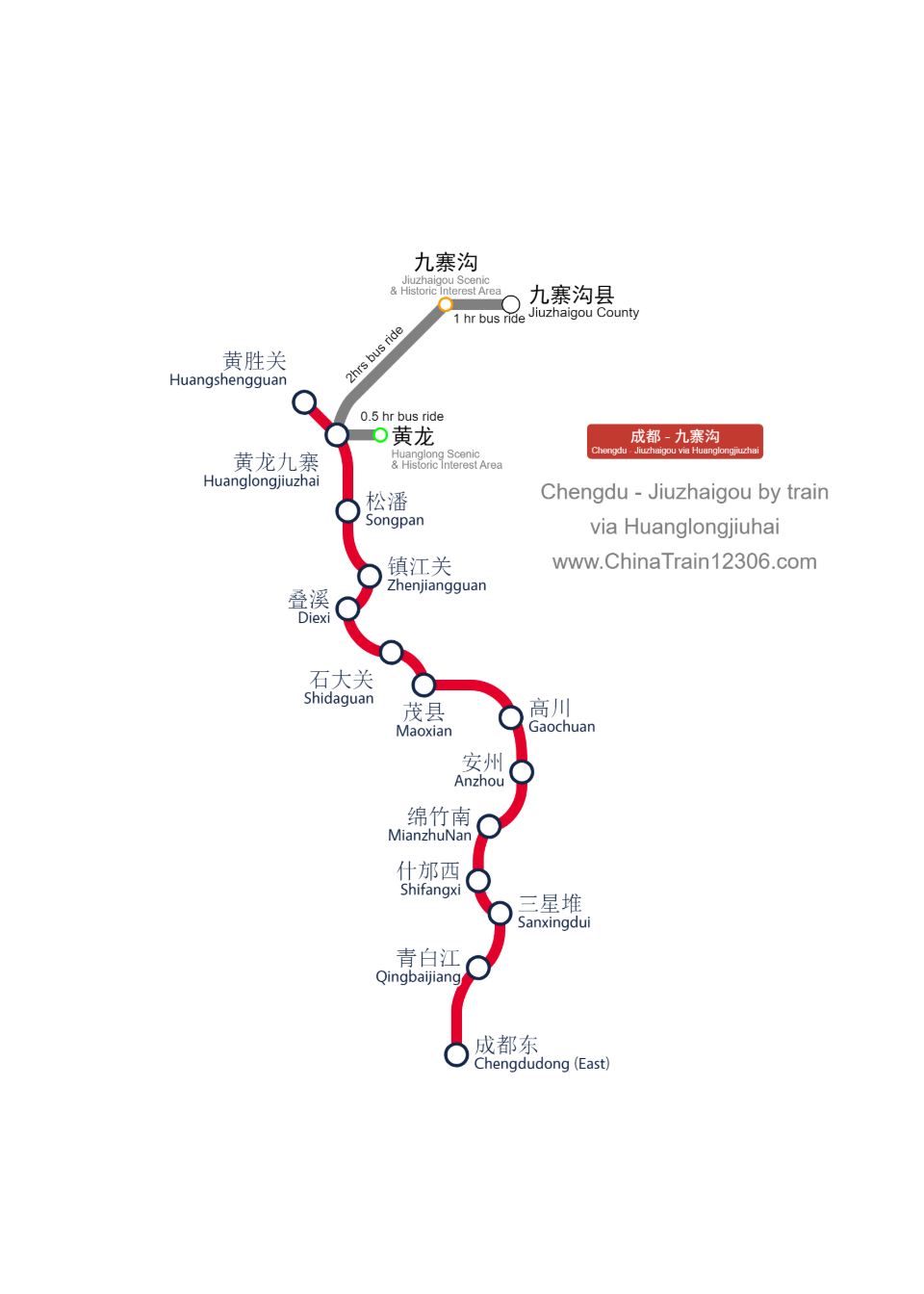
If traveling by car, people often choose Chengdu, Mianyang and Lanzhou, Gansu as starting points for self-driving. Of course, you can also choose to rent a car, which is more secure, and if you go with many people, the price is not expensive.
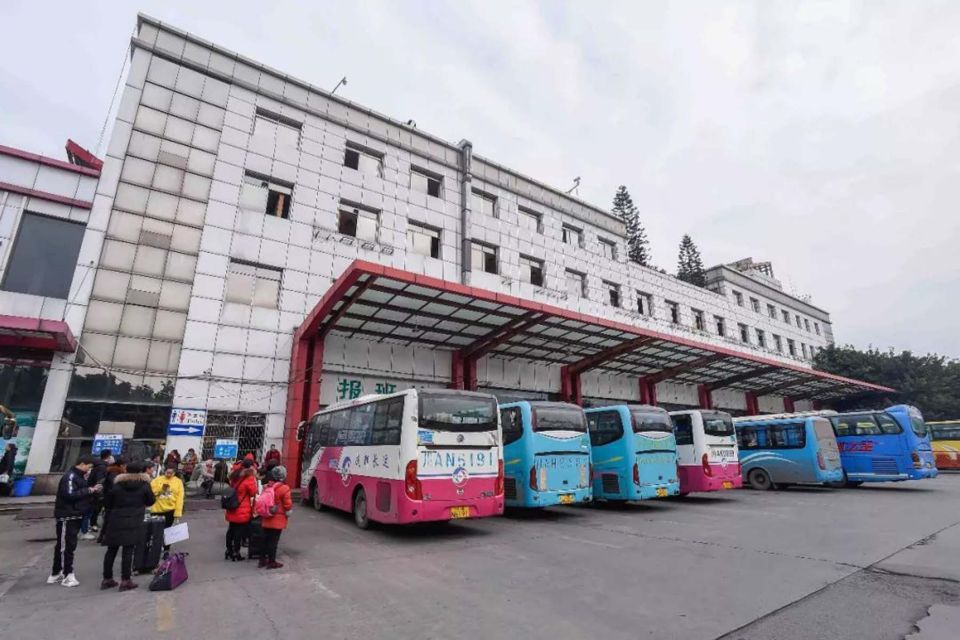
There are four direct buses from Chengdu to Jiuzhaigou departing from Xinnanmen Bus Station and two buses from Chengdu Chadianzi Bus Station every day. You can buy tickets from the self-service vending machines available in Chengdu Hongqi Chain stores or book tickets online to save time. Reference ticket price: 140 yuan/person.
What to do and where to go in Jiuzhaigou Scenic Area?
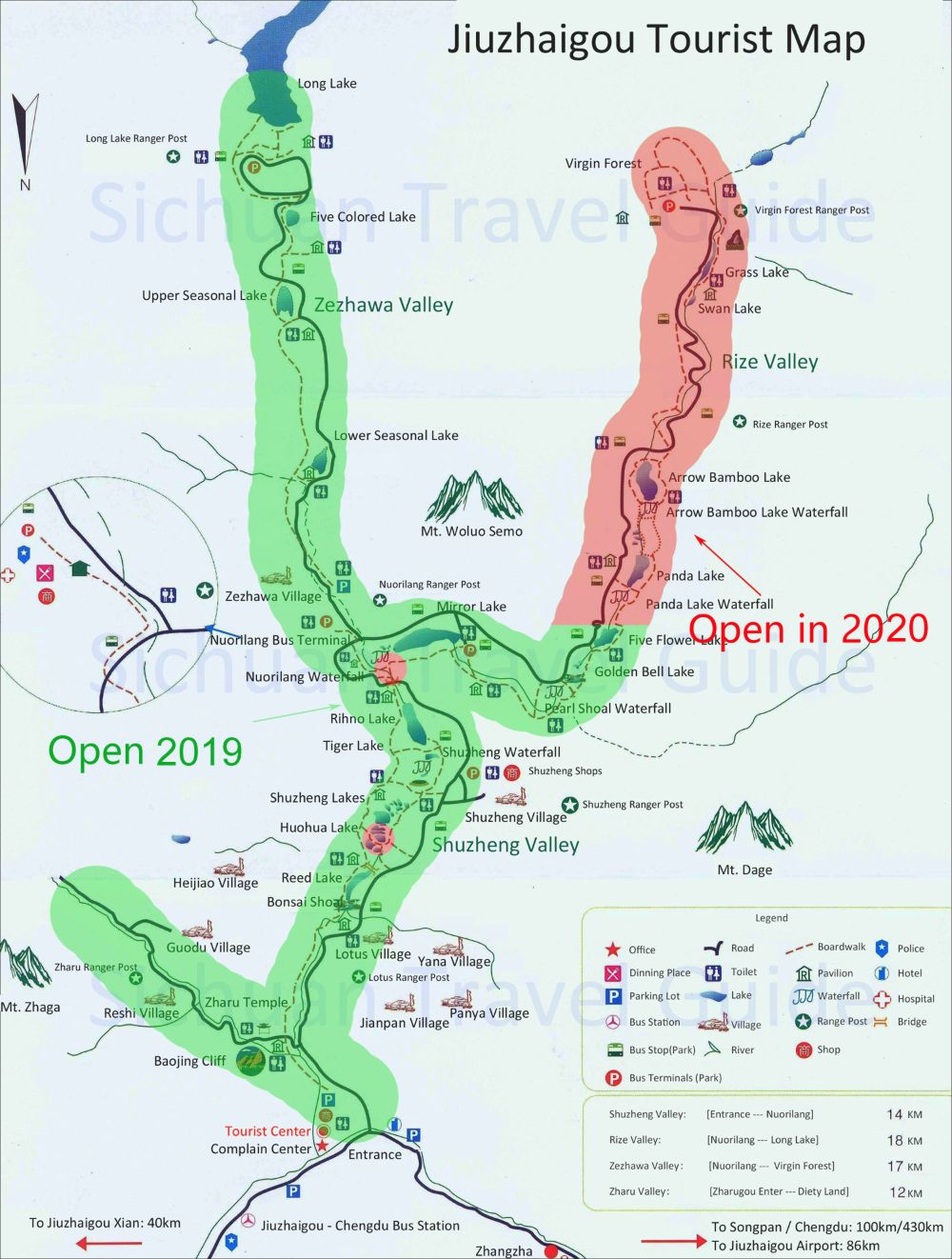
There are green sightseeing buses in Jiuzhaigou Scenic Area, or you can choose to walk on the plank roads in the scenic area. Based on the experience of many people traveling to Jiuzhaigou, you should make the most of the sightseeing buses and walking boards to easily explore the entire scenic area.
Jiuzhaigou Valley has opened four scenic tourist routes: Shuzheng, Rize, Zechawa and Zharu, with a length of more than 60 kilometers. The scenery is distributed in six major scenic spots: Shuzheng, Nuorilang, Jianyan, Changhai, Zharu and Tianhai.
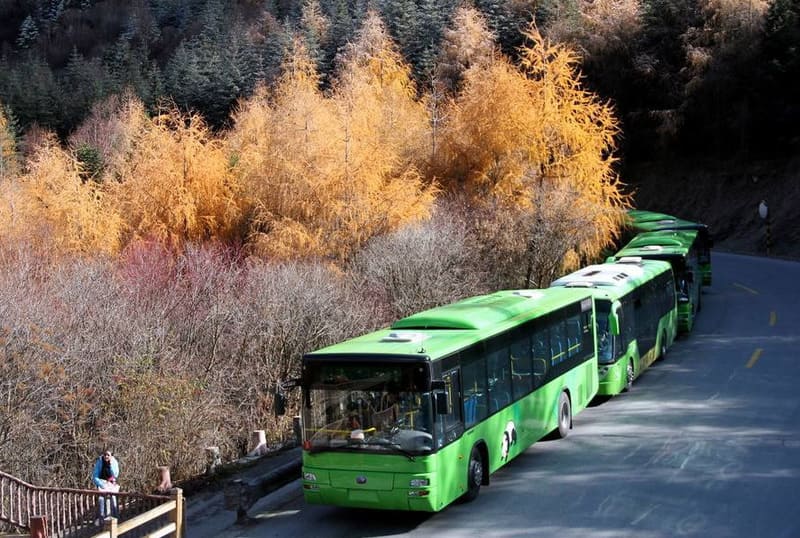
The main attractions of the three main ditch branches of Jiuzhaigou are as follows:
Shuzhengou Valley
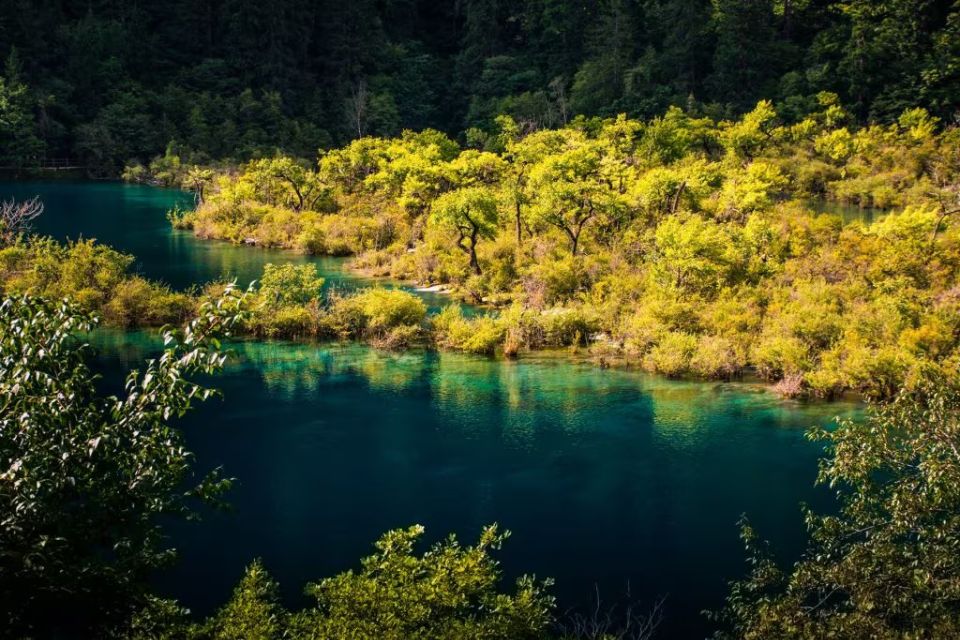
Shuzheng Gou is a “Y” shaped ditch, which is the section from the mouth of the ditch to Nuorilang Waterfall. There are magical and mysterious waters, colorful streams, ponds and waterfalls dotted with trellises, majestic waterfalls, primitive factories and swaying prayer flags that make people dizzy.
Shuzhenggou is 2280m above sea level. The biosphere terrain here is formed based on the deposition of limestone layers, creating the Shuzheng Valley flow. From there, it forms 19 lakes of different sizes, divided into layers along the valley.
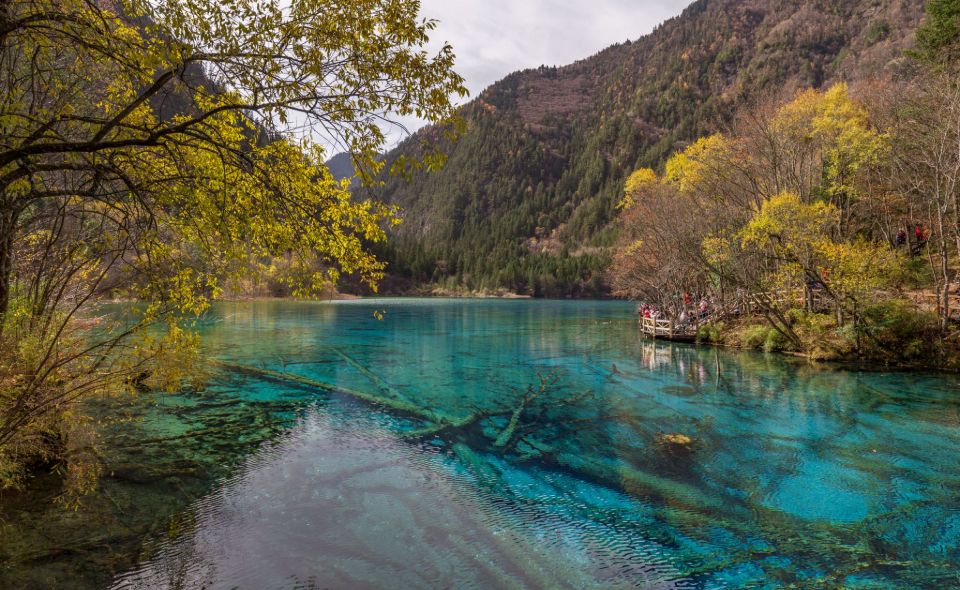
All include: forests, lakes, small waterfalls intertwined with each other, creating a unique scene with captivating beauty. You will have new experiences when visiting this land.
Shuzheng Gou is the gateway to the scenic beauty of Jiuzhaigou Valley, with more than 40 lakes (haizi) of various types, accounting for about 40% of the total lakes in Jiuzhaigou Scenic Area. Surprises on every path, beautiful scenery on every path, clear water and Yao Chi on every path.
Main attractions in Shuzhenggou: Nuorilang Waterfall, Shuzheng Waterfall, Shuzheng Village, Bonsai Beach, Lotus Leaf Village, Rhinoceros Lake, Reed Lake.
Rize Gou Valley
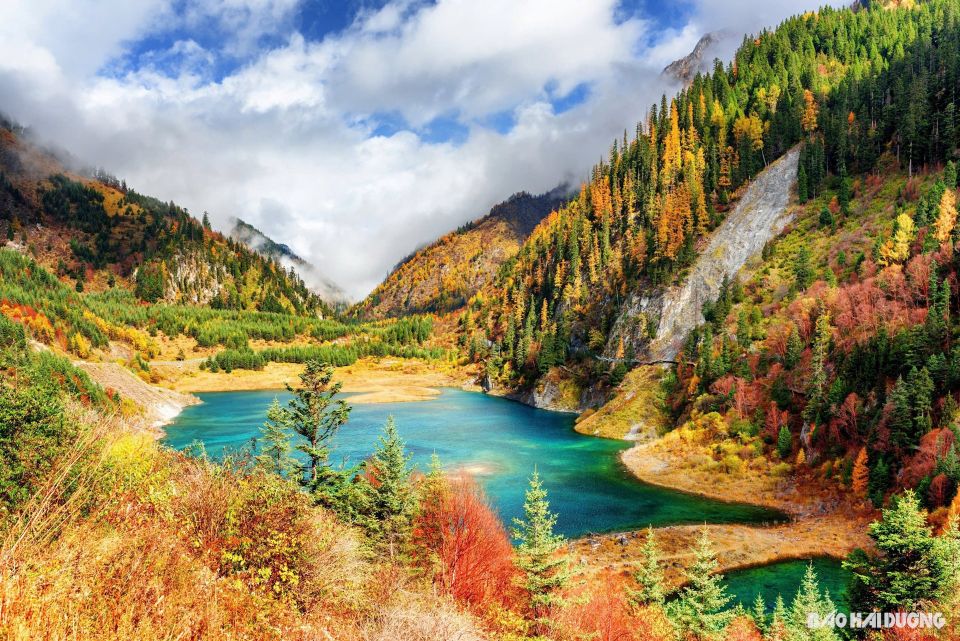
The Rize Valley section is the right-hand “Y” shaped ditch, which is the section from Nuorilang Waterfall to Jiuzhaigou Primitive Forest, with a total length of 18 km. From Nuorilang Waterfall to Jianzhu Lake, it is the essence of Jiuzhaigou Scenic Area.
Main attractions of Rize Valley: Five Flower Lake, Pearl Shoal Waterfall, Mirror Lake, Panda Lake, Primitive Forest.
Zechawagou Valley
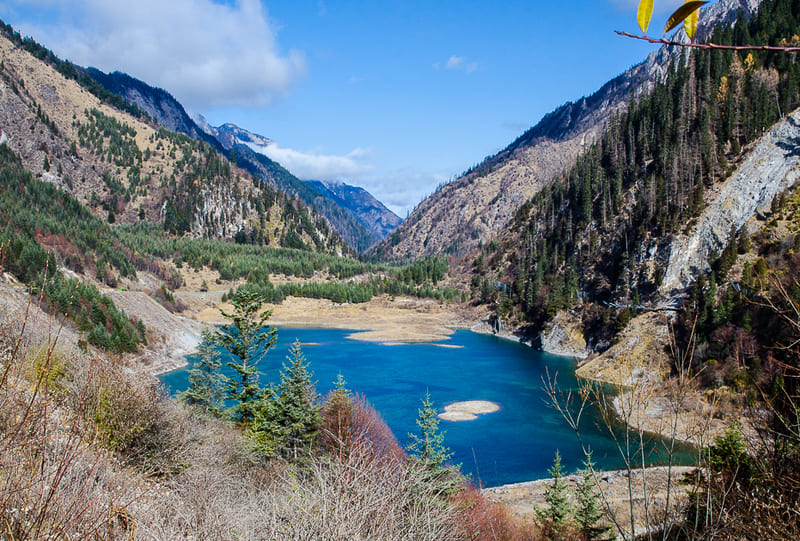
Zechawa Valley is the left ditch in the shape of the letter “Y”, from Nuorilang Waterfall to Changhai, the longest ditch in Jiuzhaigou. The main attractions of Zechawa Valley are: Changhai, Wucaichi.
Shuzheng Waterfall
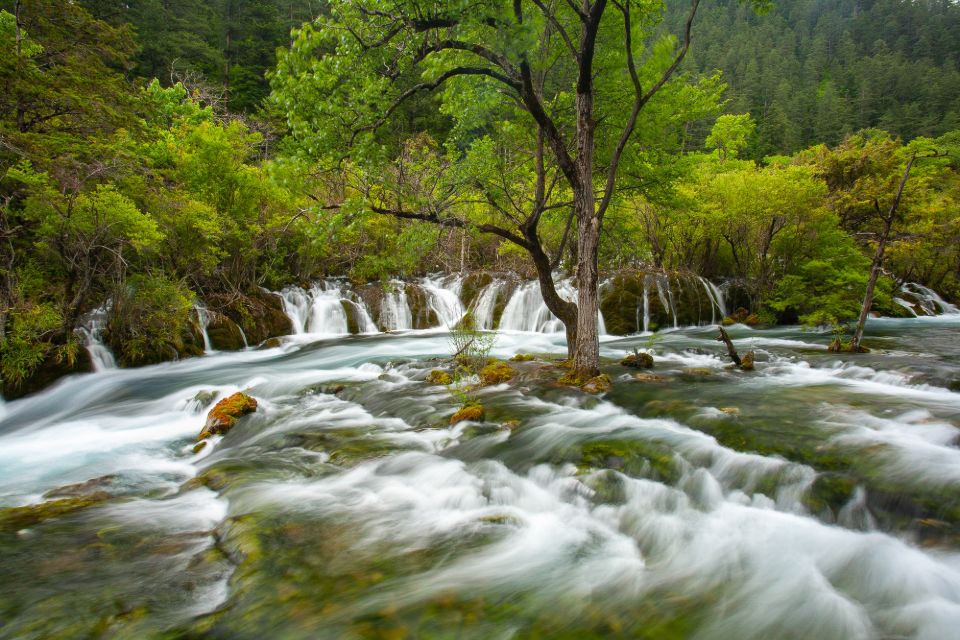
Shuzheng Waterfall is 2295m above sea level, 11m high and 62m wide. The waterfall has a convex arc shape, the water falls down the rocks forming many interesting stacked layers.
The special feature of Shuzheng Waterfall is that it is composed of many waterfalls, they are connected to each other. In addition, the bushes on the banks are affected by the water for many years. They create a special plant community and a rare natural wonder in the world.
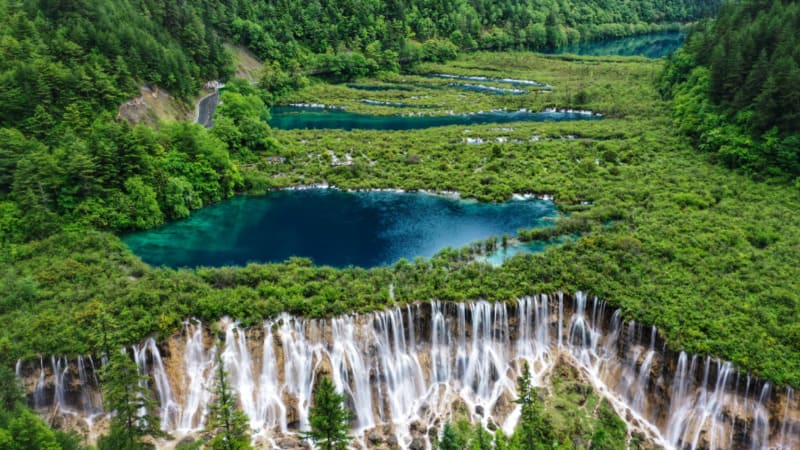
Shuzheng Village (#Jiuzhaigou travel guide)
Shuzheng Village is a small Tibetan and Qiang village. It is located in the Shuzheng Valley, behind which is the 4,200m high Dagomen Mountain. The people here often worship the “Nine Treasures Lotus Bodhi Pagodas”, because this brings them unity, peace and happiness of the 9 villages in Tibet.

A cultural village with strong ethnic identity has been built here. Where you can enjoy Tibetan-style architecture. Colorful paintings of majestic natural scenery and beautiful costumes of Tibetan people. From there, you will immerse yourself in the daily life of local people and experience the special things that only the people here have.
Huohua Lake
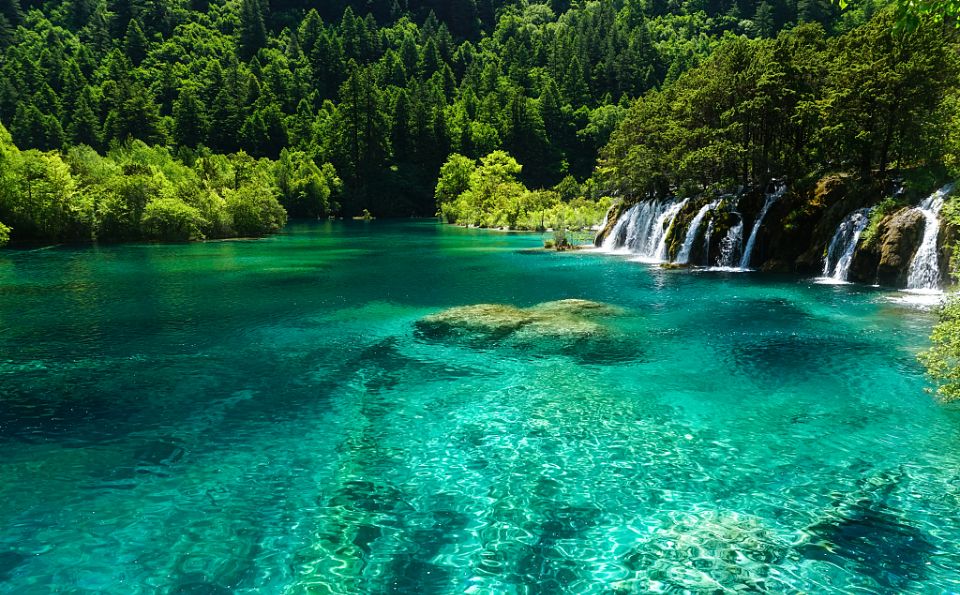
Huohua Lake (Huohuahai) is 2,211m above sea level, 294m long, 232m wide and 16m deep with a capacity of 450,000m3. In 2017, the Jiuzhaigou earthquake of magnitude 7.0 on the Richter scale caused Huohua Lake to lose its natural beauty. In response, researchers used environmentally friendly materials to repair the dam body and cracks caused by the earthquake, preventing natural disasters and restoring the lake’s landscape.
Reed Lake
Reed Lake is 2,192m above sea level, about 15m high and 10m wide, perched precariously on a limestone cliff. Over time, due to the impact of nature on the vegetation, a beautiful Reed Lake has been created like the face of a young girl. Therefore, people often call Reed Lake the Goddess Woroscielmo in Jiuzhaigou.
Bonsai Lake

Bonsai Lake is 2190m above sea level, 218m long, 98m wide and 0.8m deep. This is also the only place where a stream crosses the lake, creating the most beautiful sight in Jiuzhaigou. In the shallow water, plants such as willows, cypresses, poplars, pines and rhododendrons combine with flowers, grass and rocks. All form a colorful carpet of vegetation.
Wolonghai Lake
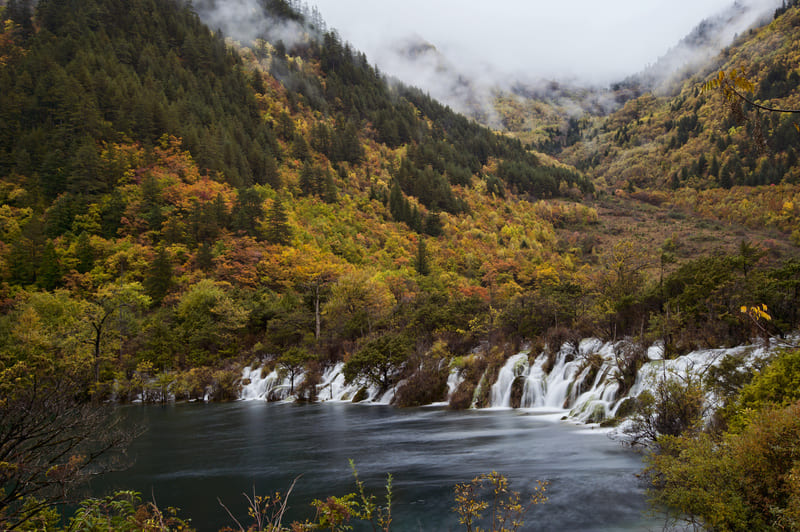
Wolonghai Lake is 2,220m above sea level, 253m long, 2,255m wide and 24m deep. At the bottom of the water are creamy yellow limestone cliffs that look like giant dragons lying under the water. When the lake surface is calm, you can imagine the image of the dragon sleeping under the clear water at the bottom. When the wind is strong, the lake surface ripples, the dragon god seems to wake up and wag his tail. When a strong wind blows, the lake surface immediately fluctuates and the dragon god flies away without a trace.
Tiger Lake
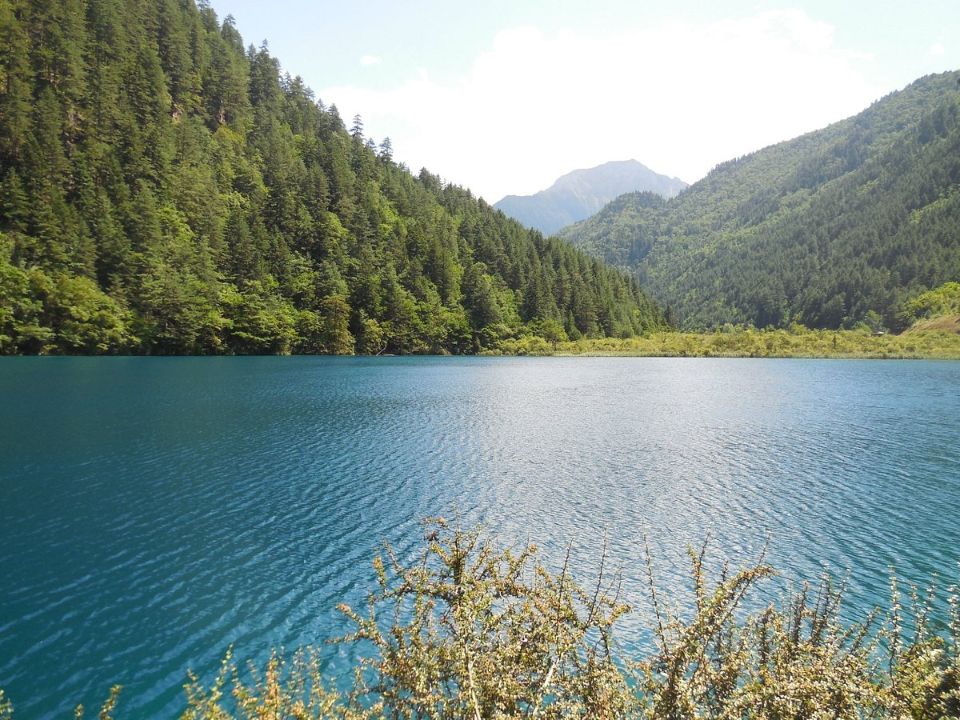
Tiger Lake is 2,298m above sea level, 310m long, 194m wide and 23m deep. In late autumn, the colorful forest is reflected in the clear water, like colorful striped tigers.
In late autumn, the forests above the mountain are dyed red and the colorful trees are reflected in the water. From there, it creates a scene like a tiger lying in the sun, so it is called Tiger Lake.
Rhinoceros Lake
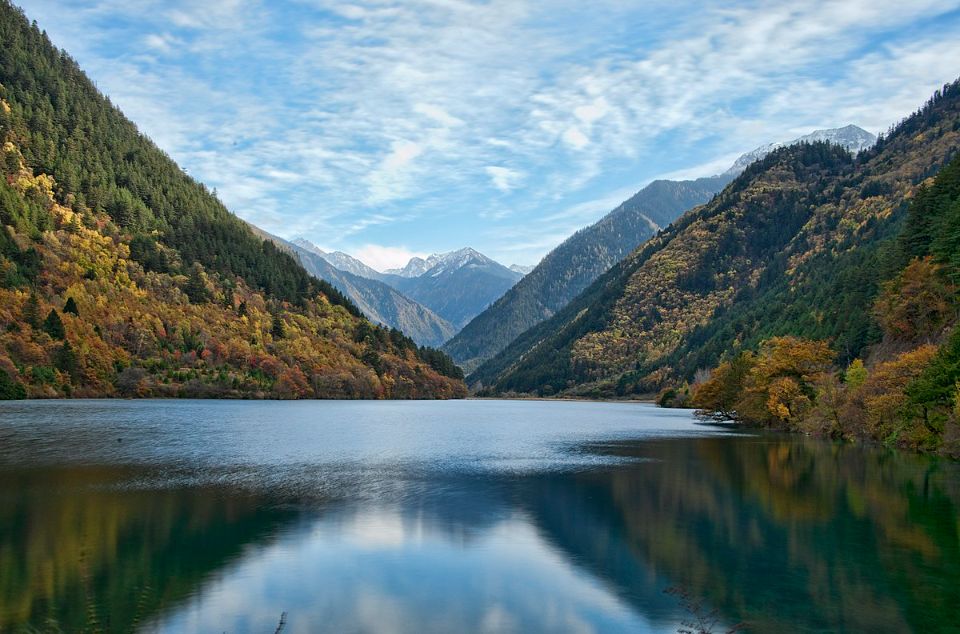
Rhinoceros Lake is the second largest lake in Jiuzhaigou with a height of 2301m, 2000m long, 225m wide and 17m deep. Legend has it that a famous monk who was seriously ill rode a rhinoceros here. Some time later, he died and left his beloved rhinoceros here, so people called this place Rhinoceros Lake.
The special feature here is shown through the seasons. In spring and summer, the lake is emerald green. In autumn, the water is clear and the mountains are reflected in the lake, creating a beautiful, enchanting scene of Jiuzhaigou.
Five-flower Lake
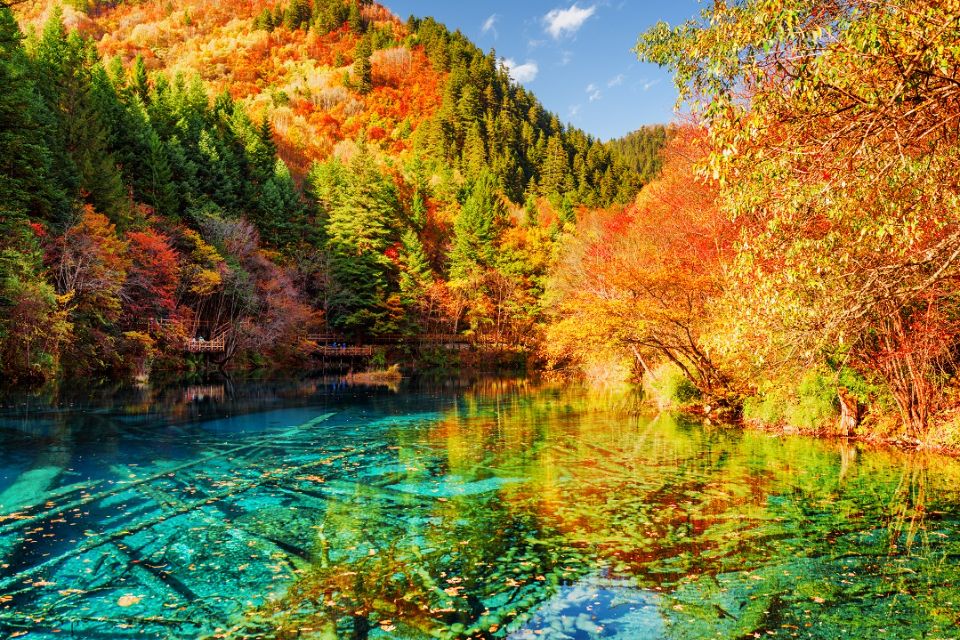

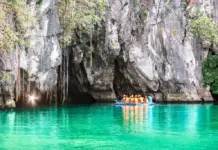

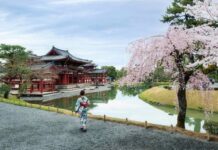
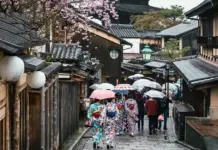
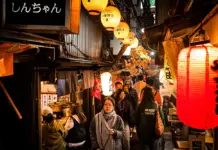
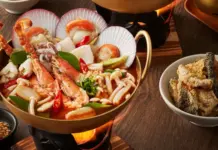
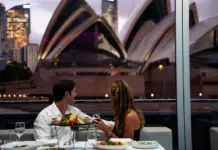

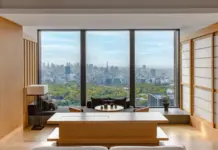

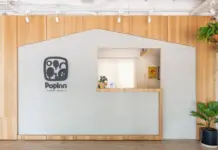
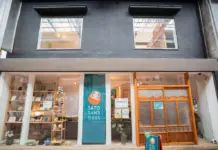

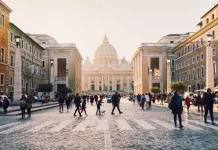
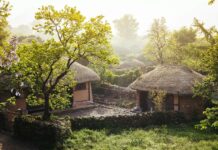






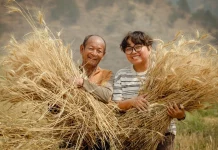






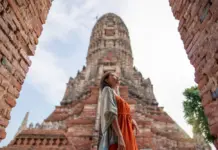
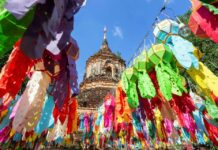

![10 best airports in Asia in 2016 [RANKED] kuala-lumpur-international-airport-best airports in asia in 2016 by skytrax ratings](https://livingnomads.com/wp-content/uploads/2016/08/29/kuala-lumpur-international-airport-best-airports-in-asia-in-2016-by-skytrax-ratings-218x150.jpg)
